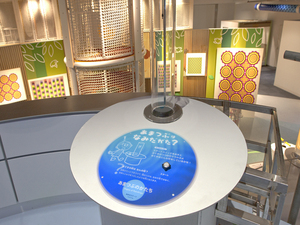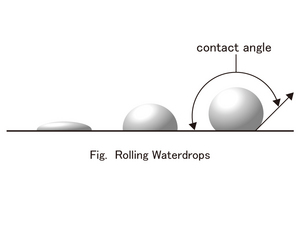Nagoya City Science Museum
TOP > Exhibition Guide > Keyword Search > Starting with "S" > superhydrophbic > Rolling Waterdrops / Shapes of Raindrops
Rolling Waterdrops / Shapes of Raindrops



Purpose of Exhibition
The water on the ground evaporates and turns into vapor. It soars upwards and makes clouds in the sky. Over time clouds are transformed into rain (water), which returns to the ground and pours into the ocean. Water circulates on the earth. In this exhibition "Exploring Water", you can deepen your knowledge about this big circulation and characteristics of water through various experiments.
We will explain two exhibits in the "rainfall stage".
Additional Knowledge
[Shapes of Raindrops]
What kind of shapes do the raindrops falling from the sky have? You may picture that they are ball-shaped, round-headed and stream-lined like a tear, but actually they are not.
When raindrops fall in the air, air resistance is applied. The bigger the size of a raindrop, the greater the resistance becomes and cannot be ignored. As a result, when a raindrop is small, its shape becomes circular. However, when a raindrop is big, the bottom part of the raindrop is slightly flattened and receives a strong resistance. That is why it looks circular.
When water appears to be a tear drop shape, that is due to dew falling off the tip of a leaf, and raindrops sliding down a window. In 1951, Mr. Chyouji Magono from Hokkaido University succeeded in taking pictures of rain drops falling in the air. It is believed that he identified its "manjyu shape" (oval- shaped) for the first time in the world. This experimental device involves producing strong wind from underneath and delaying the fall of water drops, to observe the shape of water drops.
[Rolling Water Drops]
This exhibit shows a mysterious experiment in which water drops do not get absorbed and instead keep rolling.
Originally, a water drop has a tendency to become circular. Water molecules are attracted among molecules and become small. Consequently, it is shown as a force which minimizes its surface area on water. This force is called surface tension.
However, when raindrops are on clothes, for example, a raindrop cannot keep its circular shape; it soaks into clothes, and it should look the same shape shown on the figure. Processing the surface of a textile on which water drops touch so that water drops will be repelled on the surface, is called water-repellant. Fluorine chemicals that repel water on trouser bottoms and umbrellas have been developed, but technology enhancing the quality of water-repellant has been exploited. The one with a more than 150°of contact angle shown in the figure is referred to as superhydrophobe.
CooperationProf. Osamu Takai, Nagoya UniversityTakeda Printing, Co., Ltd.
Article and illustration by: Koichi Mabuchi
